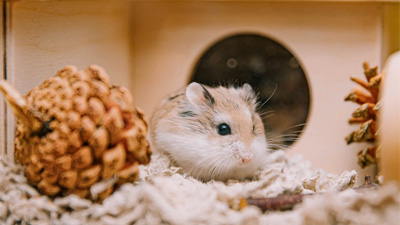Is It Better to Have 2 Hamsters or 1?

Photo by Jaroslaw Slodkiewicz on Unsplash
For prospective hamster owners, the decision of whether to have one hamster or two can be a perplexing dilemma. On one hand, the idea of providing companionship for a solitary creature may seem appealing. On the other hand, concerns about potential conflicts, increased care responsibilities, and housing requirements may arise when considering two hamsters.
In this article, we will explore the advantages and disadvantages of keeping one hamster versus having multiple hamsters as pets. By examining the diverse social behaviors and specific care requirements of different hamster species, we aim to shed light on the question of whether it is better to have one or two hamsters.
Hamster Social Behavior
Before delving into the debate of one hamster versus two, it's essential to understand the social behavior of these small rodents. In the wild, most hamster species, including Syrian hamsters and Chinese Hamsters, are solitary animals that prefer to live alone. They establish and defend territories, coming into contact with other hamsters primarily for mating purposes.
However, some species, such as dwarf hamsters, may tolerate living in pairs or small groups under certain conditions. Dwarf hamsters, in particular, have been observed forming social bonds with littermates or same-sex companions when raised together from a young age. Still, individual temperament and compatibility play significant roles in determining whether cohabitation is successful.
The Solitary Nature of Syrian and Chinese Hamsters
Two hamster species that are notorious for their solitary behavior are the Syrian hamster (Mesocricetus auratus) and the Chinese hamster (Cricetulus g-riseus). These hamsters are naturally territorial and prefer to have their own living space. Due to their aggressive tendencies towards other hamsters, it is generally recommended to keep Syrian and Chinese hamsters individually.
Solitary hamsters, such as Syrian and Chinese hamsters, thrive when they have a habitat where they can establish their territory. They require ample space, enrichment, and social interaction with their human caretakers to prevent loneliness and boredom. Providing a stimulating environment with toys, tunnels, and regular playtime is crucial for their mental and physical well-being.
The Sociable Dwarf Hamsters
In contrast to Syrian and Chinese hamsters, certain species of dwarf hamsters can tolerate living in groups if introduced correctly. Roborovski dwarf hamsters (Phodopus roborovskii) and Campbell's dwarf hamsters (Phodopus campbelli) are known to exhibit social behaviors and successfully cohabitate under certain conditions.
Dwarf hamsters are most likely to thrive in a group when they are introduced at a young age, preferably as littermates. This allows them to establish a social hierarchy and bond with each other from an early stage. It is essential to provide a spacious and well-equipped enclosure with multiple hiding spots, food and water sources, and exercise wheels to accommodate their social interactions.
The Case for Having One Hamster
Territoriality and Aggression
Despite the potential benefits of companionship, introducing two hamsters into the same enclosure can pose risks of territorial disputes and aggression. Hamsters are naturally territorial animals that may view unfamiliar individuals as intruders, leading to conflicts over space, resources, and dominance.
Territorial aggression can result in injuries, stress, and even death for the hamsters involved. Therefore, careful consideration and preparation are necessary when attempting to house two hamsters together.
Increased Care Responsibilities
Having two hamsters means doubling the care responsibilities, including feeding, cleaning, and monitoring their health and behavior. Each hamster requires its own space, enrichment, and attention to ensure its physical and emotional well-being.
Additionally, keeping two hamsters may require larger or multiple enclosures to accommodate their needs, which can be more challenging to manage and maintain compared to caring for a single hamster.
Compatibility and Behavioral Issues
Even if hamsters are raised together from a young age, there is no guarantee that they will get along or cohabitate peacefully. Individual temperament, sex, and hierarchy dynamics can influence the success of housing multiple hamsters together.
Aggressive behavior, dominance disputes, and territorial marking are common challenges when keeping multiple hamsters in the same enclosure. It's essential to monitor their interactions closely and be prepared to separate them if conflicts arise.
Considerations for Multiple Hamster Housing
While some hamsters can live together harmoniously, there are important considerations to ensure their well-being:
Compatibility: It is crucial to carefully select hamsters that display compatible personalities and establish a hierarchy without significant aggression. Introducing hamsters gradually and monitoring their interactions is essential to prevent conflicts.
Space and Resources: Providing a sufficiently spacious enclosure is crucial for housing multiple hamsters. Ensure that each hamster has access to its own hiding spots, feeding stations, and exercise equipment to reduce competition and potential stress.
Monitoring and Intervention: Close observation of hamsters' behaviors, including any signs of aggression, injuries, or hierarchy issues, is important when keeping multiple hamsters together. Any concerns should be promptly addressed by separating the hamsters and seeking advice from a veterinarian or experienced hamster owner.
Conclusion
Deciding whether to have one or multiple hamsters as pets depends on the species and their natural social behaviors. While solitary hamsters like the Syrian and Chinese hamsters are best kept alone, certain species of dwarf hamsters such as Roborovski and Campbell's dwarf hamsters can coexist in groups if introduced properly and provided with adequate space and resources. Keeping multiple hamsters can offer companionship, social interaction, and mental stimulation, but it requires responsible monitoring and accommodation of their specific needs. Ultimately, hamster owners should consider the preferences and behaviors of their chosen species to create a fulfilling and enriching environment for their furry companions.
You May Also Like
 Pet HamsterIs a Hamster a Type of Rat? Debunking the Myth
Pet HamsterIs a Hamster a Type of Rat? Debunking the Myth Pet HamsterHamsters vs. Mice: What Is the Difference?
Pet HamsterHamsters vs. Mice: What Is the Difference? Pet HamsterWhich Type of Hamster is the Friendliest?
Pet HamsterWhich Type of Hamster is the Friendliest? Pet HamsterCan Hamsters Spread Diseases to Humans?
Pet HamsterCan Hamsters Spread Diseases to Humans? Pet HamsterCan a Kid Be Allergic to a Hamster?
Pet HamsterCan a Kid Be Allergic to a Hamster? Pet RatsExploring the 7 Different Types of Pet Rats
Pet RatsExploring the 7 Different Types of Pet Rats